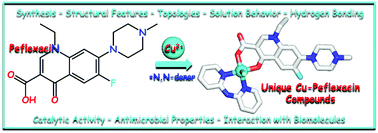Extending the family of quinolone antibacterials to new copper derivatives: self-assembly, structural and topological features, catalytic and biological activity†
Abstract
A new series of copper(II) compounds, [Cu(pef)2(MeOH)] (1), [Cu(pef)(bipyam)Cl] (2), [Cu(pef)(phen)Cl] (3) and [Cu(pef)(bipy)Cl] (4), bearing the quinolone family member pefloxacin (Hpef) were self-assembled in the presence (optional) of N,N′-donor heterocyclic ligands such as 2,2′-bipyridylamine (bipyam), 1,10-phenanthroline (phen), or 2,2′-bipyridine (bipy). The products were fully characterized, including single-crystal X-ray diffraction analysis of 2–4. The structures are extended into 1D (2), 2D (3), or 3D (4) networks via multiple H-bonds between the monocopper(II) units and guest water and/or methanol molecules; the latter are arranged into different types of water and hybrid water–methanol clusters. The resulting H-bonded networks were classified from a topological viewpoint, revealing diverse topologies that also include an undocumented type. Compounds 2–4 also act as homogeneous catalysts in a model oxidation reaction, namely the mild oxidation of C6–C8 cycloalkanes by H2O2 at 50 °C to give cyclic alcohols and ketones. The effects of various reaction parameters (substrate scope, temperature, and loadings of catalyst, cycloalkane, and oxidant) and selectivity features were investigated. Besides, products 1–4 also show remarkable antibacterial activity against four different microorganisms (Escherichia coli, Xanthomonas campestris, Staphylococcus aureus and Bacillus subtilis), which is superior to that of free Hpef. The interaction of the Cu(II) compounds with calf-thymus DNA was studied suggesting intercalation as the most possible binding mode. Furthermore, the interaction of the obtained copper(II) derivatives with human/bovine serum albumin was investigated by fluorescence emission spectroscopy and the corresponding albumin-binding constants were established. This study widens a limited family of transition metal pefloxacin derivatives.



 Please wait while we load your content...
Please wait while we load your content...